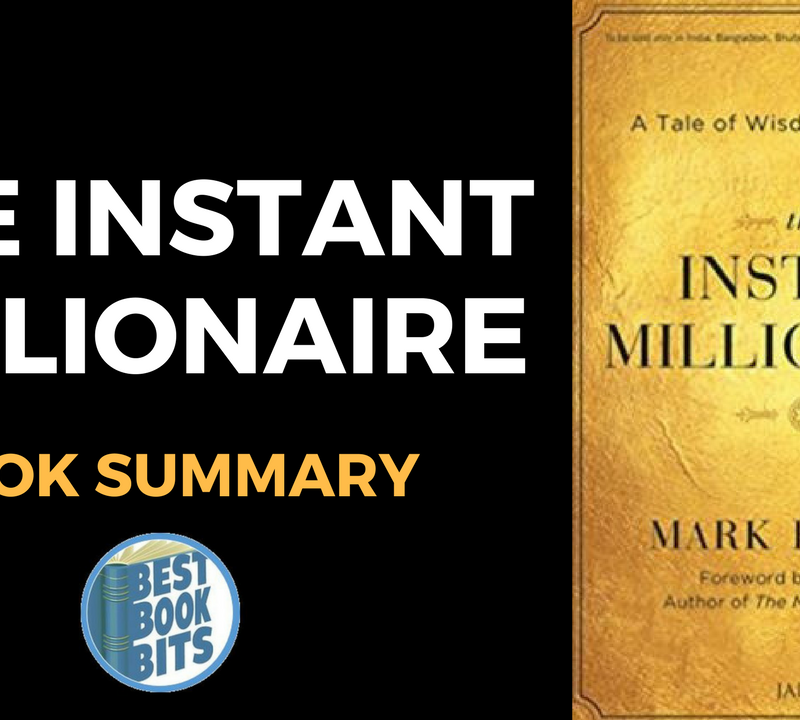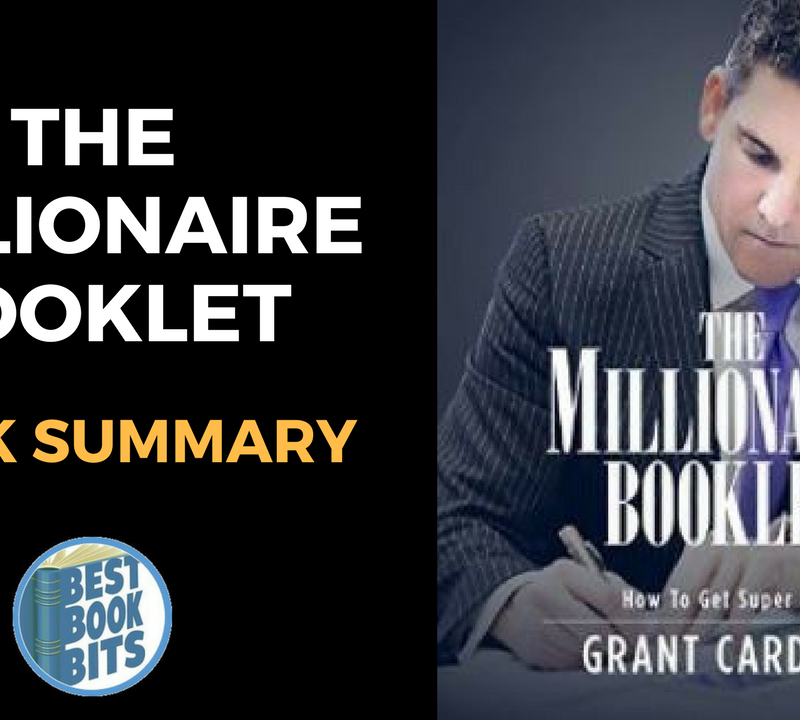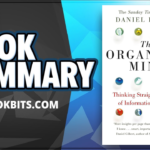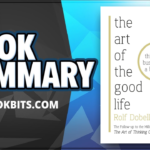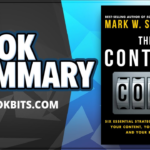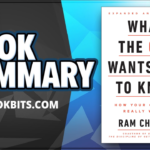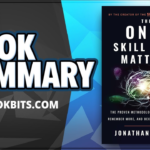GET THE 500+ BOOK SUMMARY BOX SET IN PDF & MP3 here
FOLLOW US HERE > |YouTube |Spotify | Instagram | Facebook | Newsletter | Website
This is the book your money-savvy best friend, therapist, and accountant would write if they could. It’s the book about money for people who don’t even want to think about money, until the arrival of that inevitable day when we all realize we must come to terms with this thing called money. Everyone has pain and challenges, strengths and dreams about money, and many of us mix profound shame into that relationship. In The Art of Money, Bari Tessler offers an integrative approach that creates the real possibility of “money healing,” using our relationship with money as a gateway to self-awareness and a training ground for compassion, confidence, and self-worth. Tessler’s gentle techniques weave together emotional depth, big picture visioning, and refreshingly accessible, nitty-gritty money practices that will help anyone transform their relationship with money and, in so doing, transform their life. As Bari writes, “When we dare to speak the truth about money, amazing healing begins.”
Book Summary
An area of your life that you’d rather not think about, let alone talk about. One last taboo that can still turn your palms sweaty and give you that icky, pit-in-the-stomach feeling. It’s the elephant in the room.
MONEY.
Money was the elephant in the room during that family dinner when you announced your new career—and watched your parents panic. Money was the elephant sitting between you and your sweetie that weekend you gave each other the cold shoulder after fighting about whether to take a vacation this year. Money was the elephant in the room when you berated yourself after splurging on those boots you weren’t sure you could afford.
Probably, money has been the elephant in the room your whole life. Because here’s the truth: no one has taught you how to really deal with him.
You’ve tried following mainstream “money guru” frameworks and creating super-strict budgets to whip the elephant into submission. But you inevitably fall off the wagon and feel like a failure.
You’ve toyed with more spiritual ideas of “money as energy” and tried to cultivate a mindset of abundance. But without grounded practices and financial know-how, this quickly devolved into mere wishful thinking.
You’ve tried turning your back on the elephant, sticking your head in the sand, and tossing bank statements, unread, straight into the trash. But the elephant is still there … and ignoring him is getting awkward.
Absolutely everyone, regardless of age, race, gender, economic background, or musical taste, has shame and stuck places around money. Yet we also all have our strengths, dreams, and gifts in the financial realm.
Money isn’t just about the numbers: it’s also about our relationship with ourselves. In order to shift our relationship with money, then, we must untangle old patterns and challenge our assumptions about ourselves. This is tender work, and I have learned that a nurturing, gentle, and radically un-shaming approach is the only way.
Building a healthy relationship with money
Helps ground all aspects of life. If you already have a mindfulness practice, expanding it to include how you handle money will strengthen it by leaps and bounds, and if you don’t have a mindfulness practice, money is, perhaps surprisingly, a beautiful place to start.
The methodology outlined in this book focuses first and foremost inside rather than outside, on what I call the “micro” side of money: our individual, internal relationship with money.
When we speak the truth about money, deep healing happens. Taboos are broken, veils lift, and radiance breaks forth.
I believe our money work is never done, but rather evolves, right along with us, from cradle to grave.
Deep money work isn’t magic. It’s conscious transformation: tiny step after tiny step, day by day, breath by breath.
Why are you really here?
The Eight Money Areas
Many of us grow up learning that, when it comes to money, thou shalt keep thy head firmly in the sand. See no money. Hear no money. Speak no money.
Then, for many of us, there comes a moment. A wake-up call. The realization that we must come to terms with this thing called money.
Sometimes, this call is unmistakable and deafening: a bankruptcy, an inheritance, a career change, or having a child. Yet many people hear smaller whispers, for years: quiet, subtle invitations, drawing their attention ever closer to this crucial, sorely neglected area of life.
I’ve listed these eight areas in no particular order, as this journey is not linear.
- CLARITY
About half the people I’ve worked with have sheepishly admitted to me at some point that they have no idea how much money they’re earning, spending, and saving each month (let alone the total amounts of their assets and debts). A protective fog of ignorance obscures their view of their financial situation, and they’re desperately ready to slice through it—yet also terrified by what they may see.
- INTIMACY
You know yourself pretty well.
In many areas of life, you are the expert on yourself: your strengths, your challenges, and all of your idiosyncratic patterns. Yet, for most people, this intimacy stops short at money’s door. You may not know how you behave with money, what your spending patterns are, or how you really feel about earning. You may not know what your strengths, challenges, and quirks are around money. As with most things in life, when we don’t know what’s motivating our behavior—or perhaps even what our behavior is—there’s very little chance of it changing.
Intimacy with ourselves around money entails bringing a curious, compassionate mind to our behaviors and what’s motivating them. It means paying gentle attention to what we do and don’t do with our money, to how we talk about it, to our thoughts and the whole range of emotions around it, from subtle to overwhelming. This self-awareness opens the door to choice, transformation, healthy control, and an expansion of joy.
- KNOWLEDGE
The language of money can feel like some sort of jabberwocky, concocted by a malicious madman determined to make things as hard and confusing (not to mention boring) as possible. Many people feel financially illiterate, and are understandably intimidated by this area of life—especially because most of us never received a real financial education, in incremental steps, from childhood on up.
Here’s the great news: the language of money actually isn’t that diffcult.
- EASE AND PEACE OF MIND
Many people experience significant stress and anxiety about money, regardless of how much (or how little) they have. A 2015 study by the American Psychological Association found that almost three-quarters of people surveyed experience financial stress, and a recent survey by SunTrust Bank revealed money as the leading cause of stress in relationships. Couples fight dirty about money, even when they’re conscious, skilfully communicators in every other area of their relationships. Money evokes a constant stream of worry for most.
Simply getting clear on their numbers is a huge relief: their stress stemmed not from a lack of money but from a lack of money clarity. You might access greater ease once you’re consistently engaging with your money in a regular, ongoing, and conscious fashion.
- SUCCESS
Success is incredibly subjective, so I encourage you to discover (or create) your own definition of it.
- VALUE
Value is intimately intertwined with money, and many of our struggles with money are, at heart, part of a quest to find, feel, and claim our own self-worth.
- HOPE
Some people arrive at this money work in near or complete despair.
Hope cracks open a sun-drenched window in what looked like a brick wall. If you’re here, you have some hope. Each step you take forward in your money journey, no matter how tiny, will grow and deepen your hope.
- SUPPORT
“Pull yourself up by your bootstraps. Take responsibility. Be self-reliant. Just do it!” Many of us grow up hearing messages like this and repeat them to ourselves for many painful years to come.
We haven’t been taught to ask for support within our money relationship. Many people don’t realize this kind of support even exists—or, if they do, they don’t allow themselves to receive it.
Creating a financial support team isn’t a shameful act that means you’re weak, dumb, or lazy. Getting help is one of the smartest, most pro-active and empowering things you can do.
The three phases of deep money work.
PHASE ONE. MONEY HEALING
This is the emotional work of creating an honest, mature relationship with money. Here, we dissolve shame. We get clear on the “Money Story” we’ve accumulated over the course of a lifetime (and all the patterns we’ve inherited from our family of origin, lineage, and culture). We identify and unwind patterns that no longer serve us. We claim our value. We learn emotional and body-based practices to support our journey, and ensure we are working with self-care, acceptance, and love along the way.
PHASE TWO. MONEY PRACTICES
This is the practical, nuts ’n’ bolts, number crunching, systems and habits of an ongoing and clear-eyed relationship with money. Here, we gather data. We learn the language of money. We set up daily/weekly/monthly/annual practices to engage with our numbers. We strive to do all of this in ways that are personally meaningful, aligned with our deepest values, and feel creative, playful, and life-affirming. (Bye bye, dry, dusty budgeting. Hello, values-based bookkeeping!)
PHASE THREE. MONEY MAPS
This is the big picture of your goals, dreams, and plans, how they’re unfolding, and how money can fuel them. Here, we learn to make great money decisions, based not only on the numbers but also on your values, phase of life, and more. We look at where you’ve been in your life, what’s on the horizon, and how this moment fits into the grand scheme of your money relationship—and your precious human journey.
The Money Healing phase gives us the emotional support and foundational tools to dissolve the resistance, shame, or other emotional patterns we all have around money. The Money Practices phase translates these deep insights into real-world actions, breathing them to life. Finally, the big picture visioning of the Money Maps phase situates all of this within the unfolding narrative of our unique lives—and infuses it with personal meaning.
Ultimately, the Three Phases aren’t a linear, step-by-step program. They are fluid and organic. Interwoven. Each phase is always happening, and each one affects the other.
PHASE ONE
- money healing
- Welcome to the first phase of our journey together.
- Here, we explore the vast terrain of our hearts.
- We trace the intimate details of our past.
- We practice loving awareness.
- We dissolve shame.
- We unwind old patterns that no longer serve us.
- We claim our value.
- We forgive.
- And we celebrate.
- My, oh my, do we celebrate.
- This deeply personal, inner work is our foundation.
- It is gentle and deep, universal and uniquely yours.
- Deep breath. Let the healing begin.
CHAPTER 1 Healing money shame
It is a universal human experience, able to cut us all to the quick, whether we’re six or ninety-six. Though its sources shift over the course of our lives, it never loses its potency. When it comes to money, shame is present somewhere in us all, whether it’s right at the surface or swept under the rug, prompting big changes or holding us back from even starting our money healing journey.
Learning to recognize, understand, and transform money shame is a cornerstone of Money Healing.
We all carry money shame. Women, men, black, brown, white, young, old, short, tall, gay, straight, billionaires and paupers, spreadsheet enthusiasts and number-phobes, self-made entrepreneurs, welfare recipients, and trust funders. Money shame is an equal opportunity affliction, and it does not discriminate based on who you are, where you’re from, how much money you earn, what percentage you save, whether you pay your taxes on time, or what your credit score is.
What Is Money Shame?
Money shame might be a universal human experience, but each of us carries our own types and flavours of it, which are as unique as our fingerprints. Your money shame might be tied to a specific experience in your life, your upbringing in general, or none of the above.
Here are some of the ways money shame can show up:
That queasy pit in your stomach as you approach the checkout line, wondering if your card will be declined .
Pangs of guilt when you decide how much to charge for your new product or service.
Feeling hot, sweaty, and anxious when the topic of money comes up in your extended family.
Anxiety around talking about money.
Fear or guilt that you don’t have way more saved for your future.
Some money shame feels acute and all consuming. Yet there are also more subtle forms of money shame, and some of us only experience fleeting pangs of it here and there, when a memory surfaces or a late fee arrives,
As soon as money came in, like the tide, it went right back out.
Money shame can feel like anything from a tightened jaw to a queasy stomach to sleepiness, anxiety, or grief. While it’s often tempting to stuff down the unpleasant feeling of money shame, it is far more helpful to recognize it when it arises, and call it by its name—no matter how huge or small it feels. By noticing, naming, and honoring even this challenging emotion, we crack a doorway into other, gentler, more reassuring states of mind.
Where Does Money Shame Come from?
Most of us were simply not taught about money: how to manage it, how to talk about it, and least of all how to navigate our feelings about it.
In the absence of this much-needed education, we project like crazy onto money: we conflate it with our identity, our sense of worth, our definitions of success and maturity, beliefs inherited from our community, lineage, culture, spiritual aspirations, and on and on.
As shame and vulnerability researcher Brené Brown explains, “Shame needs three things to grow exponentially in our lives: secrecy, silence, and judgement.” We’ve already seen these three ingredients in action: most of us keep our money shame to ourselves, never (or rarely) speak it aloud, and berate ourselves for even having it.
As Brown continues, “Shame cannot survive being spoken. It cannot survive empathy.”
Gentleness: The Only Way Out of Money Shame
One of the trickiest things about money shame might be its ability to shapeshift. I’ve seen money shame masquerade as many, many different things. For example, cynical judgments that wealthy people are spoiled and heartless might hide a deep shame of being raised by a poor single mother. The belief that a welfare recipient is lazy may stem from a guilty unease around the privileges you’ve been handed. Perhaps the most ubiquitous mask money shame wears is that of the helpful self-disciplinarian: “I have to keep beating up on myself about this money stuff so that I toe the line!”
The path out of money shame is not getting smarter or working harder or restricting your spending more harshly. You hold the shaming whip in your own hands and it won’t stop hurting if you lash yourself harder or in a new spot.
“tough-love” approaches to money, while they might work on a practical level for a time, never create sustainable, positive healing. Saying you’ll heal your money shame by getting your act together with budgeting is simply madness. The path out of money shame isn’t shaming yourself harder; it’s finally putting down that lash, releasing those unrealistic standards, and cultivating every last drop of forgiveness, self-love, and compassion you can muster. Tough love is simply not an effective way to heal emotional wounds.
Alienation. Others assume I’ve had everything handed to me on a silver platter, and throw epic judgments and projections my way.
Entanglement. Family money often arrives with strings attached, complicating the already challenging process of getting to know yourself and becoming your own person.
Guilt. Who am I to have these resources, when others in the world are struggling, even starving?
Fear. I’ve been given so much, but do I deserve it? Am I worthy? Will I ever be able to accomplish enough, share enough, or make a big enough difference in the world with this money?
Self-doubt. Could I have made it on my own? Could I ever truly be self-reliant and earn without help, just from my gifts, sweat, and brilliance?
Shame thrives in the dark, silent lands of taboo, so bringing the light of consciousness and courageous truth-telling can dissolve even the deepest, oldest shards of money shame. There is such healing in speaking the truth about money. Especially when it comes to releasing old patterns of shame and blame.
There’s unrestrained freedom, and there’s balanced freedom.”
Money shame keeps us tight-lipped, even with those closest to us.
“People talk about [money] like it’s this dirty little secret. We can’t talk about it or, the flipside, we can only talk about the good stuff. So you feel like the one jerk who’s had a hard time. On one level, it’s silly. But on another level, it’s crazy harmful.”
CHAPTER 2 The body check-in
HOW TO DO A BODY CHECK-IN
It all starts with a pause. Stop whatever you’re doing. Take a moment for yourself.
Gather up all of your attention and turn your gaze within yourself.
Take a few deep, slow breaths. Close your eyes, if this feels good and helpful to you. Adopt an attitude of openness and curiosity. Without judgment or any attempt to change anything, simply notice. Start with your physical sensations: become aware of how your body feels on your chair or how your feet rest on the earth. Notice sensations of movement and stillness: the breeze across your skin or the quiet stability of your pelvis. Notice how your breath feels, moving in and out: is it deep, shallow, cool, tight?
Next, gently observe the emotions moving through you. Do you feel angry, anxious, annoyed, or awestruck? How do these feelings feel, in your body? Is your jaw set in hot determination, or do you feel a flutter of excitement in your belly? Allow yourself to simply be aware of these emotions and how they feel in your body.
Also notice any thoughts, images, memories, or self-talk. Like clouds floating through the sky of your mind, simply notice them. No need to cling to them or push them away—simply acknowledge them. Are self-criticism, judgment, or other challenging sensations arising? Notice. Are elation, excitement, or other expansive sensations arising? Notice these, too.
As you scan your body, emotions, and mind, you may like to ask yourself if there’s anything you’d like to remove from or add to your situation. If you notice your jaw is tight, perhaps you’d like to wag it loose. If you notice your breath is shallow and quick, you might gently lengthen and deepen it. Come home to your body, here. Follow your breath. This isn’t about perfecting or even changing anything—it is simply about being aware.
Once you’ve done your first Body Check-In: repeat, repeat, repeat. I recommend this practice before, during, and after every money decision or any of the money interactions you face throughout your day, from teensy to monumental.
As you encounter pieces of money shame, work through your Money Story, or take yourself on a Money Date.
Using the Body Check-In within our money relationship brings us to transformation’s Square One: awareness.
Awareness → Understanding → Transformation.
In your money life … and beyond.
Many of us have mindfulness practices in other areas of life—on the yoga mat, in conversation with our sweetie, or while eating—yet neglect to bring this same awareness to money. When confronted with an overdue tax bill, even the most mindful among us tend to get scattered, overwhelmed, or numb. That’s why one of the first things we become aware of when we start practicing the Body Check-In is just how unaware we typically are.
This is one reason the “just do it” approaches to money management often fail: how can you possibly stick to a budget or limit your credit card spending when you “check out” at the checkout counter? Awareness comes first, then understanding; and finally, transformation.
Deep money issues aren’t about the numbers. If you make more money, they don’t go away. Making more money won’t heal them—awareness does. The marker of growth isn’t necessarily that your issues disappear. It’s that you’re able to move through them when they arise, and you can prevent your core money issues from making major money decisions for you.
First comes awareness of what’s happening—however challenging or stressful it may be. Then comes understanding of what’s happening—beliefs, habits, ingrained patterns shine forth, illuminated. Finally, a doorway opens, and hope beckons with a golden finger: conscious transformation is possible, here. You can choose a healthier pattern. You can un-shame yourself. With practice, you can move through all of this faster and faster, more and more easily.
CHAPTER 3 Your money story
Something happens in our earliest encounters with money that shapes us for the rest of our lives.
When we access our earliest memory of money, freeze-frame it, and really examine it, we will inevitably find that, there and then, in that moment, we made a decision about money. Money is dirty. Money equals power. Money is for those other people, not me. Money equals survival. Money equals happiness. This decision, however irrational and unconscious it may be, drives and shapes our money relationship for the rest of our lives. Sometimes, it will serve us; at other times it will shackle us. It will show up loudly, in big money decisions, and sneakily, in seemingly insignificant ways (that might add up to big, life-long patterns). As conscious adults, when we shine the light of awareness upon this seminal memory, re-experience, understand, and lovingly witness it, we empower ourselves with choice. We can liberate the gifts locked within that memory and cut loose any tethers that had bound us to it, against our will.
I often refer to money as one of life’s “gardens,” one of those important aspects of our life we need to consciously cultivate. Like spirituality, sexuality, or food, these gardens are there whether we’re aware of them or not. Without loving attention, they can wither or become overgrown with weeds; with too much watering and pruning, they may become soggy or fragile. It is up to each of us, at every phase of life, to discern the just-right amount of attention and care our money “life garden” needs. These earliest money memories are much like the first seeds planted in these gardens, eventually growing into the central, imposing fixtures of our financial lives. They are the focal points, the towering oaks, around which whole ecosystems grow, even though we often remain unaware of their existence.
As conscious adults, when we bring these early money memories into focus, we can choose how to care for them: we can prune them back or even encourage them to stretch their limbs along a beautiful new trellis.
Meet Your Money Story
As pivotal as these initial money memories can be, there’s much, much more to your relationship with money.
This panoramic view of your past and present relationship with money is what I call your Money Story. Your Money Story is the entirety of your relationship with money, from the tiny details to the major events. It’s as unique as your fingerprint and includes the whole shebang: the historical facts of your financial life; inherited patterns from your family of origin, lineage, and culture; how you take on or rebel against them and integrate your own beliefs and behaviors around money; and all the sensations and emotions that get stirred up in this terrain.
You begin exploration of your Money Story in the present moment. First, center yourself with a Body Check-In. Then, look at your current relationship to money: how you feel about earning, spending, saving, and so on. Once you feel current and aware, you can begin the next phase of the journey, into the past. You can gently explore memories and lovingly turn over rocks. Clear the cobwebs and shine lights. Perhaps you can push even further into the past, examining what messages you’ve received about money from your religion, ancestral lineage, or culture.
When we can clearly see the past and its influence on our present relationship with money, a whole new world of choice opens up for us.
We have the power to rewrite our Money Stories. We can sift through our histories and distinguish the facts from our subjective experience, interpretation, and the meaning we’ve made of them. Through awareness, understanding, and un-shaming, we can heal our Money Stories, reframe old beliefs, shift patterns, and create utterly new, delightfully meaningful beliefs and practices around money.
Our personal, unconscious definitions of money come to define us. That’s why bringing awareness to them is so doggone important.
How “Grown-Up” Are You, with Money?
Over the years, hundreds of people have admitted to me that when it comes to money, they still feel like children. When a financial stress arises, their wits and emotional sophistication fly out the window, and they instantly feel like an infant, a toddler, or an adolescent. They might throw an inner tantrum (like a two-year-old), crumple into a preverbal haze of fear and confusion, or even explode into a rebellious, “I hate the world!” teenager.
Such childlike reactions around money are hardly surprising. Many of us truly are like children when it comes to money, simply because we have not worked with it consciously or enough to mature our relationship with it yet.
So many of us are afraid to slow down and listen to these younger parts of ourselves. We might already judge ourselves for not being more of a grown-up around money, and we’re afraid that, if we listen to that rebellious teenager or anxious toddler, they will take us over. Yet it is only when we take the time to truly honor and get to know these younger parts of ourselves that we can create a relationship with them, become whole, and move forward into clear-headed maturity.
Updating your financial identity, asking yourself on a regular, almost daily basis: “Who am I now? What’s my current identity, with money? How does this person earn, manage, save, and spend?” Quickly finding out that sometimes you need both inner and outer updating to keep up with your evolving relationship to money.
Your financial identity is fluid and subjective.
Update it anytime you like.
As we trace our Money Stories, most of us bump into this universal truth about money: we have all received certain advantages and disadvantages. We were all born into a lot in life. At a certain point, many of us enter the sticky, sometimes tender territory of comparing our Money Stories with others. Our hearts break when we see our parents working long hours into their seventies, just to make ends meet, while others live in opulent mansions. Or we feel guilty for our own abundance when others have so little.
We cannot truly heal a wound without forgiveness. Writing new chapters in our Money Story usually involves completing old ones, which means seeing them, learning from them, and letting them go. There is beauty in this release. With a little guidance, we can honor old parts of our Money Story, and gather their wisdom, while gently, cleanly cutting our ties with them.
MONEY STORY VISUALIZATION
Create a safe, sacred space for this exploration. You may want to light a candle, say a prayer, or pour yourself a cup of tea. Take your time. Move gently. Insert Body Check-Ins before, during, and after. If you find yourself rushing, slow down. You may want to answer all of these questions at once, or you might insert a few moments or even days between each section. Explore with compassion and curiosity. Let this be an act of mindfulness and self-love.
- DESCRIBE YOUR CURRENT RELATIONSHIP WITH MONEY
- VISUALIZE YOUR MONEY PAST
- CONNECT THE DOTS BETWEEN PAST AND PRESENT
- GIVE YOURSELF A HUG
CHAPTER 4 Forgiveness, completions, and letting go
THE VERY FIRST money workshop I led began with ten men and women gathered in a circle in a cushion-strewn living room. These brave money adventurers swore they wanted to create new, healthier, and happier relationships with money. But despite their hope and determination, something held each one of them back. It was as if heavy chains were keeping them anchored to painful elements in their money stories: outdated money beliefs, shameful secrets, unresolved relationship dynamics, and even to practical To Do’s they hadn’t checked off their lists.
Resolving these old chapters of your Money Story is simple: mail that tax return, set up a payment plan with the collection agency, or have that chat with your brother about the money he owes you. Often, though, the work of releasing, forgiving, and letting go is a little harder, more subtle, and more internal. Here, we don’t just need action: we need deep money healing before we can move forward and write that new, more hopeful chapter in our Money Story.
This is the tender realm of forgiveness. Here, we come full circle back to money shame … and release it. Gently, baby step by baby step, with as much mindfulness and courage as we can muster, we transform our shame. We grieve, forgive, complete, and let go.
No act of forgiveness is too small if it liberates energy for you.
The Levels of Letting Go
As with most everything in our money relationship, there are levels to completing lingering bits of your Money Story.
Practical: Hire an accountant, get yourself organized on TurboTax, clear the clutter from your desk, organize your files, pay off that credit card, collect money someone else owes you, set up a manageable payment plan with the IRS, make an appointment with a consumer debt advocate, coach, or other financial professional who can offer you support.
Emotional: Speak your truth to someone (in reality or through a letter you never send), release old emotions, stories, and dynamics that no longer serve you (but keep knocking on your door), let go of some adolescent rebelliousness, honor your need for support through this healing journey by working with a financial therapist.
Mental: Sift through your beliefs about money and consciously affirm or reject each one.
Spiritual: Voice anything unspoken (especially grievances) in your relationship with whatever your conception is of something greater than yourself (even if you don’t have such a concept at all). We all define this spiritual level of money in our own way, but for me, it’s about working with deeper levels of trust, thriving, and tithing, and shedding negative, stuck energy within myself regarding money.
The Gifts of Forgiveness
“Practicing forgiveness means letting go of self-righteous anger, blame, and resentment. That’s hard. The combination of self-righteous anger, blame, and resentment is one of my favorites. Umm. Umm. Umm. Drink it up! Unfortunately, I think it’s toxic and eats you alive from the inside. It might go down like a milkshake, but it burns up your insides like battery acid.” —Brené Brown
BABY STEP: COMPLETIONS
Find a quiet, comforting time and place, free from distraction and disturbance. Surround yourself with things that comfort and reassure you. Do a Body Check-In and anything else that helps you relax and connect with yourself.
When you’re ready, ask yourself: What would I like to complete in my money relationship? What am I ready to let go of, release, or say goodbye to?
There are always two sides to forgiveness: the letting go and the moving forward. Looking back to the past and stepping forward. Releasing and creating anew. It seems paradoxical, but when we look back at our pain from the past, honor it, and release it, we can also move forward in new, more liberated ways. We let go of old beliefs about money and choose what new beliefs we want to bring forward with us, into the future.
Forgiveness is tough work. It is a journey. But the rewards are huge. liberating your energy reserves and vastly expanding compassion for yourself and others.
THE GIFT OF PEACE
“Forgiveness is not always easy. At times, it feels more painful than the wound we suffered, to forgive the one that inflicted it. And yet, there is no peace without forgiveness.” —Marianne Williamson
When we cannot (or will not) forgive, we are, effectively, haunted by our past. We may harbor unprocessed sadness, rage, fear, insecurity, or a host of other emotions, beliefs, and dynamics.
We must bring our old money patterns, hurts, and unfinished business into loving awareness. Only then can we loosen their hold on our hearts.
I believe we all experience varying levels of hurt, loss, and trauma, from large to subtle can be incredibly healing for our Money Story. We need to grieve the career that ended, mark the end of a marriage (and the financial partnership and dreams that died along with it), honor the moment we turned down that high-paying job, lay to rest the shame of a bankruptcy or loss of a house. Peace comes when we find ways to honor these parts of ourselves, these dreams that didn’t come to fruition, these metaphorical deaths (both large and small). Peace comes when we write love notes to them, adorn their graves with flowers … and let them go. Then, we can move forward, lighter, freer, and at peace.
THE GIFT OF COURAGE + PERSONAL POWER
“The weak can never forgive. Forgiveness is the attribute of the strong.” — Mahatma Gandhi
Losing a home is one of the biggest financial traumas that can befall a person.
Not every completion is as huge and traumatic. Yet whatever their size, we can bring loving awareness and conscious forgiveness to the endings and transitions in our financial life. We can walk away with a bit more resilience, having learned just how strong we truly are.
THE GIFT OF APPRECIATION + PRESENCE
“The present moment is filled with joy and happiness. If you are attentive, you will see it.” —Thich Nhat Hanh
“Enough” isn’t out there; it’s a relationship to what you already have. Unless you work on that first (or simultaneously with how you’re making money), you will never feel like you have enough, and you will always feel poor. It’s possible to feel fat when you’re thin, and to feel poor when you’re rich. The thing that changes is your relationship with “enough.”
It’s so common to hold on to resentment toward our parents for how we were raised, including the money beliefs they instilled in us, from a young age. When we can muster the courage to recognize that, no matter how harmful someone’s actions may have been toward us, they were being driven by their own habits and Money Stories, we can experience true healing compassion.
One of the most important people to forgive is yourself.
THE GIFT OF WHOLENESS
“I call all of my power back to me now. I am whole and complete.” —Danielle LaPorte
Forgiveness actually calls parts of ourselves home from exile, so we become whole again.
Five Myths About Forgiveness (And What to Do Instead)
We often harbor misguided ideas about what forgiveness is that hold us back from practicing it.
Myth #1.
Forgiveness means condoning, letting someone off the hook, or excusing them from any wrongdoing.
“You stole my money, but that’s OK. I forgive you.”
Reality: True forgiveness is more about letting yourself off the hook than the other person. Chronic anger, resentment, and blame are not free. They cost us energy. And energy that’s bound up in the past is energy that’s not available to us in the present. Forgiveness, therefore, is primarily about self-care:
Myth #2.
Forgiveness means whitewashing the impact of someone’s actions.
“You raised me to believe girls can’t be good with money, but I guess that didn’t really mess me up that much, so I forgive you.”
Reality: Acknowledging the harm done is often an important first step toward forgiveness.
Myth #3.
Forgiveness is unnecessary, as grievances will fade away on their own, over time.
“I hate that my sister screwed me out of my inheritance. But I’m not going to think about it. I’m sure I’ll get over it, someday.”
Reality: Sometimes, pain softens on its own, but it can also crawl underground and fester, stinking up a whole relationship. Time alone does not wash away strong anger; anger is potent energy that stays lodged in our body-mind system until it is transformed or released.
Keep in mind: most of us have a longer list of grievances toward ourselves than anyone else.
Myth #4.
Forgiveness is an all-or-nothing proposition: flip the switch and all is forgiven.
“It’s been ten years, and I still can’t forgive myself for defaulting on that loan. I guess I never will.”
Reality: There are stages and phases and levels of forgiveness and letting go, and most people move through them gradually, over time.
Myth #5.
There is one way to forgive, and we should all do it the same way.
“My mother forgives so easily! There must be something wrong with me for still being upset about that bankruptcy.”
Reality: We all forgive in our own way, in our own time. Some personality types are more “hard-wired” to cling to resentment, while others may be champion repressors who only appear to forgive.
Forgiveness is the inner work of letting go and moving on. Without this inner work, resistance often wins out, and we don’t have a real hope of acting on the practical, nitty-gritty To Do list in our financial life.
CHAPTER 5 Money healing rituals
“Life is a ritual of love. Life is a ritual of union, and Life is a dance of the divine” —Vishwas Chavan
FORGIVENESS, GRIEF, AND letting go are ongoing practices that affect us all in personal ways and on many different levels. If you find yourself face-to-face with a particularly large, deep, or old part of your Money Story that you’re ready to release, and you like the idea of infusing your forgiveness with some extra beauty, meaning, and sacredness, you might want to create your own Money Healing Ritual.
Rituals do not need to be elaborate, long-winded, or even public. Even the simplest daily tasks can become deeply meaningful and transformative when infused with mindfulness and intention.
Rituals do not have to be somber and serious. They can be celebratory, spontaneous, and lighthearted.
As you explore your personal Money Story and begin consciously crafting your relationship to money, ritual is one way to help you take the insights and desires that bubble up and integrate them into your life.
Ritual aligns our inner and outer worlds and affrms our commitment to transformation and healing. It pulls our intentions into the material world, and infuses everyday reality with sacred awareness.
THE TYPES OF MONEY HEALING RITUALS
RELEASING, FORGIVING, LETTING GO
Cut the chains to old money patterns, beliefs, or identities that no longer serve you
MARKING A TRANSITION
Cross a threshold into a new identity, chapter, or relationship with money.
CELEBRATING
Too often, we jump from one accomplishment to climbing that next mountain, without taking a breath. We need to take the time to celebrate our successes, so we can integrate them and appreciate the goodness in our lives. Celebrations get us re-inspired and propel us forward.
BLESSING
Send something out into the world with loving intentions.
Ritual is one way to love yourself into transformation, rather than shaming or yelling yourself into change.
In ritual, we declare our readiness for change. We honor and release our past, consciously affirm our choice, and step toward our future with clear intentions.
The striking paradox of letting go: when we release our old, stagnant beliefs about money, we have room in our hearts to create new, happier, healthier beliefs of our own choosing.
“The more we’re willing to remove the veils, the more radiant we become.”
Many of us deeply cherish elements of our family and our heritage. Yet, at the same time, our family and ancestors are often the sources of much of our negative, limiting money beliefs.
Ritual as a Creative Process
Personal Money Healing Rituals help us cultivate and access the deeper mysteries of our lives, our selves, and even what is greater than us. Each of us needs to go inside and access the voices, movement, wisdom, and languages that will guide us as we create our own healing.
A personal Money Healing ritual need not be elaborate, complex, or lengthy to be deeply transformative. When we slow down and trust the body’s wisdom, it will reveal to us what we most need.
Seven Elements of a Personal Money Healing Ritual
- SELECT AND INSTRUCT YOUR WITNESSES.
- HAVE A CLEARLY DEFINED BEGINNING, MIDDLE, AND END.
- HONOR THE OLD AND CALL IN THE NEW.
- RELY ON METAPHOR.
- PAY ATTENTION TO THE SPACE.
- BE AS PRESENT AS POSSIBLE.
- HONOR YOUR TIMING AND RESISTANCE.
CHAPTER 6 It’s never just about the money
Our money relationship brings us into direct contact with a whole range of deep, complex themes, including:
- Our relationship to pleasure, abundance, and thriving
- How we access feelings of “enoughness” and safety
- Our capacity to feel worthy and valuable
- Our self-confidence, self-reliance, and resilience
- Our ability to get vulnerable and ask for help
We all have our own constellations of challenges, patterns, and essential inquiries associated with money—and, like peeling back the layers of an onion, new and deeper issues reveal themselves the longer we work with our money relationship. Money always mirrors our inner world: the unresolved issues, suppressed gifts, and growing edges. So when we get brave and bring love and mindfulness to our money relationship, it can become a sacred training ground where we unravel old knots, practice new skills, and learn to tango with these tender, essential elements of life.
Over the years, I have seen themes emerge for people in their money work, again and again. Five of the most common are: Safety, Enoughness, Responsibility, Value, and Power.
Four Somatic Practices for Cultivating Safety
- SLOWING DOWN
- GROUNDING
- RESOURCING
- TITRATION
Enoughness
Here are a few emotional and psychological practices to help you cultivate feelings of enoughness from the inside out.
- GET CURIOUS ABOUT ENOUGHNESS IN YOUR BODY
- FILL YOURSELF UP WITH CHOICE
- PRACTICE GRATITUDE
- Responsibility
- Power
- Value
PHASE TWO
CHAPTER 7 Money as a self-care practice
Self-care practices like these aren’t merely To Do–style chores: they are essential for keeping us happy, sane, and growing. When we take the time to love and replenish ourselves, we reconnect with our true nature and return to the world more capable of sharing our gifts
The Three Levels of a Money Practice
I find it helpful to divide a Money Practice into three levels: physical, emotional-psychological, and spiritual.
At the physical level, we get things done. We:
- Get online and check our balances
- Track expenses, spending, savings, and investing
- Review and reconcile our accounts
- Pay bills
- Work with our financial support team (friend, partner, bookkeepers, accountants, coaches, attorneys, consumer debt advocates, etc.)
At the emotional-psychological level, we practice being compassionately mindful of our moment-to-moment experiences with money. This is the realm of awareness, healing, understanding, and transformation:
- Practice the Body Check-In: notice any sensations, emotions, or patterns around your money
- Gently work through resistance
- Journal about feelings, memories, hopes, and dreams about money
- Work on forgiveness and Money Healing Rituals
- Do financial therapy
At the spiritual level, we explore the idea that money carries our deepest values and connects us with what matters most. This may include:
- Trust: Relax into the larger vision of your life, and know that you are taken care of
- Thriving: Deepen your experience of prosperity and abundance, whatever that means for you, in this phase of your life
- Generosity: Express your generosity and deep caring for others in ways that feel good, aligned, and sustainable for you. In some years, this might mean donating ten percent of your income to a charity; in leaner times, you might volunteer at a food bank once a month.
Getting Started: Preliminary Steps
DAILY MONEY PRACTICE
You may choose to spend five to ten minutes per day (or every other day) interacting with your money in the following ways:
Save and track your expenses
Mini-Celebrations. Please be on the lookout for any opportunity to congratulate yourself for money work, large or small.
MONTHLY MONEY PRACTICE
- Love up your space. Reconcile your accounts.
- View, review, and refine.
- Refine your plan.
- Celebrate!
ANNUAL REVIEW
This is the Mount Kilimanjaro of Money Dates. Once a year (or every six months, if you prefer), you will gently and compassionately review the year that you just lived. In the Annual Review, you will follow the same process as the Monthly Practice, but instead of looking at just one month, you will review the entire year, at once.
Connect with what phase of life you are in, what is most important to you now, and where you are headed. Take stock of what the preceding year (or six month period) has been all about in the grand vision of your life, and do your best to set intentions for the year to come, knowing that you can’t know everything that will happen.
Your Money Practice is a golden opportunity to explore and hone compassionate discipline.
When beginning a Money Practice, it is incredibly helpful to rely on formality and structure. Schedule your weekly and monthly Money Dates in your calendar, always at the same time.
Empowerment as “bringing the light of awareness and awake-ness into every area of our lives.
CHAPTER 8 The spiritual level of a money practice
“The true task of spiritual life is not found in faraway places or unusual states of consciousness: it is here in the present. It asks of us a welcoming spirit to greet all that life presents to us with a wise, respectful, and kindly heart.” —Jack Kornfield
“Cultivating the capacity to be fully present—awake, attentive, and responsive— in all the different circumstances of life is the essence of spiritual practice and realization.” —John Welwood
“This very moment is the perfect teacher, and it’s always with us is really a most profound instruction. Just seeing what’s going on—that’s the teaching right there. We can be with what’s happening and not dissociate. Awareness is found in our pleasure and our pain, our confusion and our wisdom, available in each moment of our weird, unfathomable, ordinary everyday lives.” —Pema Chödrön
Trust
Many people find it incredibly challenging to trust themselves with their finances.
Trust may be the most profound gift of money work as well as the most fundamental practice within it. There is a rhythmic, cyclical nature to life (and money). When we recognize this, we can relax into trust. We can know, with faith and certainty, that everything in life is transitory and ephemeral and even the most challenging moments will pass.
Generosity
In many religious and spiritual traditions, generosity and even tithing (giving ten percent of your income to your spiritual community) are encouraged.
“Attention is the rarest and purest form of generosity.” —Simone Weil
Thriving
I’m not a huge fan of the word “abundance.” Over the past twenty years or so, it has become a buzzword for anything having to do with money. I prefer the word “thriving” to describe that incredibly powerful and essential human experience marked by dignity, joy, and resilience.
Thankfulness
Take the time, take a moment, take a breath, and be grateful for all that you have, all that you’ve done, and all that you are.
- Slow down.
- Bring loving attention to this precious moment.
- Relax into the rhythms and cycles of life … and money.
- Honor yourself.
- Bring your fullest self to your money work.
- Tap into your essence, beneath the worry and mental chatter.
- Cultivate your connection with truth, beauty, and goodness.
- Seek opportunities for gratitude.
- Feel the fullness of this moment.
- Let trust in.
CHAPTER 9 The art of the money date
The Money Date: What IS it?
A Money Date is simply a time and space for you to connect with your money relationship. This is the regular, ongoing practice that breathes life into a money relationship.
How to Take Yourself on a Money Date
As with any good date, taking a little time to get prepared can make your Money Date all the more effective, meaningful, and fun.
Money Date:
- THE PRACTICAL LEVEL
What do you need to do regularly to have a better sense of where you are with your money? You might log into your online banking, check your balances, and pay bills, if they’re due. You could organize your receipts and add up your income and expenses for the month.
- THE EMOTIONAL LEVEL
Remember: the practical, nitty-gritty, number-crunching of your money relationship is emotional, too! Be gentle and patient with yourself, here. Do a Body Check-In before diving in
- THE PSYCHO-SPIRITUAL LEVEL
What truly matters to you? Perhaps rename those boring budget categories to remind yourself of what you value.
CREATE A SAFE SPACE
It’s crucial to set an intention, before every Money Date, not to shame or blame each other. Agree to hold space for each other’s stories, vulnerability, emotions, and desires.
MONEY TIME WITH YOUR HONEY: 4 PHASES
- STORYTIME
Carve out a special time and place to share your Money Story with one another.
- ALIGN AND COMPARE YOUR VALUES
I’ll say it again: Every money conversation is also a values conversation. Take the time to clarify what your own values are and to share them, as a couple.
- DOWN TO BRASS TACKS
Once you have the emotional foundation of shared reality and have aligned your values as best you can, it’s time for some practical stuff. If you haven’t already done so, take some time to discuss and agree upon:
- Merged accounts, separate, or both?
- What tracking system will you use?
- Who does what?
- MAKE THE TIME + CREATE THE SPACE
Money Dates are about creating regular, healthy, ongoing habits with money and with each other. Staying current with all of this and with each other is the result of ongoing practices, big and small:
Quickies in the Kitchen: These are the short, casual, ongoing money chats you have about cash flow and other money matters.
Weekly Money Dates: I highly recommend scheduling regular weekly dates with your partner to reconcile your finances and attend to whatever needs your attention.
Deep Dives: Monthly, set aside a little extra time for a more comprehensive review: what money flowed in, and where did it go from there? What worked and what didn’t?
CHAPTER 10 Values-based bookkeeping
“To be a wise and good steward of money is simply to save, spend, and invest it in ways that align with my truest desires and deepest values. It’s that simple (and that hard sometimes, too).” —Lisa Byrne
The Five “Bones” of a Chart of Accounts
- ASSETS
Classical definition: Everything you own or control that contains (or could be converted into) positive economic value.
Alternative, creative, meaningful considerations: Everything above is an extrinsic asset. I believe it’s also incredibly important to list out our intrinsic assets: who you are, deep, deep down, and what gifts you bring to the world. Intrinsic assets may include your health, creativity, intellect, empathy, ability to create beauty, and on and on.
- LIABILITIES
Classical definition: Everything you owe. Your debts, credit card balances, utility bills, mortgages, student and auto loans, money you borrowed from friends and family members, etc.
- EQUITY
Classical definition: Simply put, your assets minus your liabilities equals your equity, or “net worth.” Or: what you own minus what you owe is your net worth.
Please always remember: your “net worth” is NOT your “true worth.”
- INCOME
Classical definition: How you bring in money.
- EXPENSES
Classical definition: What you spend money on.
The simple act of renaming our budget categories can be transformative. It’s a small thing, and might even seem petty or silly, but renaming can connect us with the personal value of our expenses. No longer are “my life” and “those cold, dusty numbers” living in separate rooms: your bookkeeping system reveals and
strengthens their intimate connection and reminds you of it on a regular basis.
Renaming our categories is one of the simplest and easiest of Money Practices—and a lot can happen when you shift your words.
Values-Based Bookkeeping need not be some “holier-than-thou” tool for shaming ourselves or others, but rather a loving mirror, and an invitation into ever-deepening intimacy with yourself, your values, and the truth of your life at this moment.
CREATE YOUR OWN VALUES-BASED BOOKKEEPING CHART OF ACCOUNTS
- WHAT ARE YOUR VALUES?
- WHAT ARE YOUR MONTHLY EXPENSES?
- COMPARE YOUR LISTS.
- REFRAME, RENAME, AND REIMAGINE YOUR EXPENSE CATEGORIES AT WILL.
- CELEBRATE THIS HUGE STEP YOU JUST TOOK.
CHAPTER 11 Your financial toolbox: tracking systems and financial support teams
There are two main ways to track your numbers. Some tracking systems are geared better for one kind or the other—and some systems allow you to choose either option.
1 Automatic Syncing: Some tracking systems automatically sync with your bank, downloading all of your transactions for you.
2 Manual Entry: Other tracking systems require you to manually enter every transaction into the software and to make sure everything reconciles, yourself.
Let the Real Fun Begin: Pulling Financial Reports
I recommend becoming familiar with three basic reports.
- INCOME AND EXPENSES (ALSO KNOWN AS “PROFIT AND LOSS” OR “P & L”)
- THE PRESENT VS. THE PAST
It can sometimes be helpful to compare your Income and Expense report for two slices of time: this month vs. last month
- INTENTIONS VS. REALITY
You may choose to periodically do a side-by-side comparison of your intended expenses and your real expenses.
Growing Your Financial Support Team
You do not have to know everything. You can ask for help, here. Sometimes, getting support is the strongest, bravest thing you can do.
Some of the main financial players you can add to your support team: bookkeeper, bookkeeping trainer, accountant, financial coach, financial planner, and financial therapist.
1 Start your search with friends and colleagues.
2 Check credentials.
3 Include Body Check-Ins galore.
4 Consider values.
5 Talk money.
PHASE THREE Money maps
CHAPTER 12 The three-tier money map
Budget Baggage
Many of the reasons people dislike budgets are the very reasons they fail, over and over again.
BUDGET BAGGAGE #1. IT’S ALL ABOUT DEPRIVATION
Many people think of a “budget” as a rigid, constrictive regimen that harshly limits their spending.
BUDGET BAGGAGE #2. IT’S BASED ON NUMBERS, AND NUMBERS ONLY
BUDGET BAGGAGE #3. SIX FIGURES OR BUST!
Your Money Map: A Clarion Call for Conscious Earning and Spending
Money Mapping is far gentler, more sustainable, and meaningful than traditional budgeting. It is about giving attention and loving intention to our finances so that we can harness the power of money to help us shape our lifestyle over time.
The Three-Tier Money Map
- THE BASIC NEEDS LEVEL.
These are the bare bones, bottom-line needs for your life. And only you decide what that means. Is it just groceries, rent, and utilities?
- THE COMFORTABLE LIFESTYLE LEVEL.
Here, introduce some more comfort into your lifestyle.
- THE ULTIMATE LIFESTYLE LEVEL.
Here we progress another step. Imagine having sufficient income to live out the fullest expression of your desires.
Feelings, Things, Numbers: Creating Your Three-Tier Money Map
- FEELINGS FIRST: FREEWRITE
First, write about each of the Three Tiers of your Money Map: Basic Needs, Comfortable, and Ultimate. Don’t include any numbers, yet. Turn within and get a felt sense of what each of these levels means to you. Write out your personal definitions for each tier, what you associate with them, how you imagine them making you feel day-to-day and month-to-month. This is completely subjective, and there are no wrong answers.
- THINGS SECOND: WHAT’S INCLUDED?
Once you have a felt-sense description of each of your three tiers, it’s time to look at what items are included at each level. What expenditures do you need to be able to afford to create the feelings you identified for each level?
- NUMBERS THIRD: GET SPECIFIC
Now take all of that prioritizing and bring in the real numbers. On three separate sheets of paper (or three separate spreadsheets), list out all of your monthly expense categories, for each lifestyle tier.
- COMPARE INCOME AND EXPENSES
Once you have expense totals for each lifestyle tier before you, it’s time to calculate your monthly income.
- GET HONEST: WHAT LEVEL ARE YOU LIVING?
Now that you have your average monthly income, compare it to the numbers for your Three-Tier Money Map.
- CELEBRATE!
Stretch Your Edge … Gently
By allowing yourself to dream in big ways, you will transform what might have been a dry, dusty budget into a pathway for greater self-awareness and connection with your values. Give yourself the gifts of curiosity, wonder, and joy as you play with your Money Map.
CHAPTER 13 Dancing with your money map
MONEY AREA #3. SAVINGS
Savings is a muscle. You have to strengthen it. Practice setting aside money, every single week. Even if it’s only one dollar. Over time, this adds up—and so does your capacity to save. It’s a discipline, and you’ll only get better at it if you start now.
MONEY AREA #4. DEBT REPAYMENT
Dealing with debt almost always necessitates some Money Healing: working with any shame around the debt and even renaming it something that energizes you to repay it with enthusiasm and appreciation. For example, you might rename “student loan debt” “amazing education” or repay your “lifesaving health help” instead of “medical bills.”
MONEY AREA #5. INVESTING
Striking Your Perfect Balance
50 percent for Basic Needs
This might be your “Basic Lifestyle Tier,” and includes the bare essentials: rent/mortgage, groceries, utilities, minimum loan payments, etc.
30 percent for Wants
These are life’s “nice-to-haves,” and might include vacations, entertainment, clothes, eating out, gifts, etc.
20 percent for Savings, Debt Repayment, and Investing
“Regularly reassess where you are and where you want to be in relation to your evolving values and priorities. Get comfortable with the truth of your money situation, no matter what it is. From here you can take action. This is where your true power lies.”
CHAPTER 14
How to make a good money decision
HOW TO MAKE A MONEY DECISION: BARI’S GO-TO FRAMEWORK
Consider five main factors:
1 The Numbers
2 The Timing
3 The Value
4 The Cost
5 The Intention
CHAPTER 15 Solving money koans
SOME MONEY DECISIONS have no quick and easy solutions, no matter how many spreadsheets and maps and lists we make. How can I earn the money I need to have the life I want and work little enough to have the life I want? How can I release this primal anxiety around enoughness? How can I get from here to there when I’m stuck?
“Money Koan” is the term I use to describe those big, complex questions and challenges: those nuts that take some time to crack. Whether you’re longing to release a deeply ingrained money belief or struggling to break through a money ceiling, sometimes it can be helpful to reframe the questions, themselves, as koans.
The concept of a koan comes from the Zen Buddhist tradition, where it’s used to describe a question or paradox to be meditated upon (sometimes for years) to lead the practitioner into a vaster place within themselves, beyond their ordinary, rational mind. A koan is a bit like a riddle—except it transforms you into the answer. So long, that is, as you sit with it patiently,
When we sit with a money koan long enough, we can discover (or create) new solutions, new possibilities, and new ways to do things around money, even when stress is high or things seem impossible.
While money koans don’t always feel welcome, they are always an opportunity for growth—if we seize them.
“Some of life’s questions, conflicts, and problems are so big, so deep, so complex, that we cannot simply solve them. These are invitations into transformation. These are moments when life is calling us to expand. Here, our task is to soften, open, and allow these ‘problems’ to solve us.” —Rob McNamara

